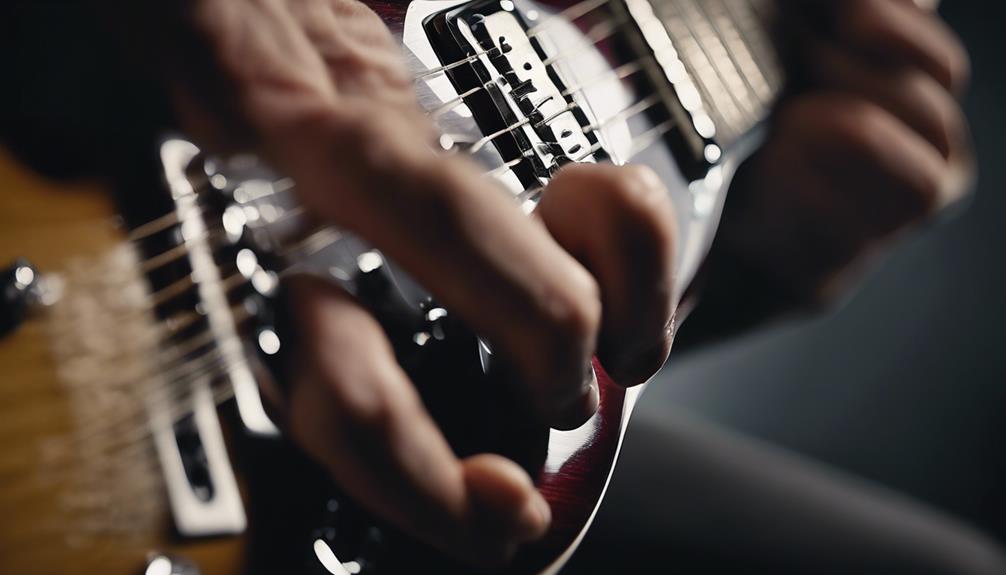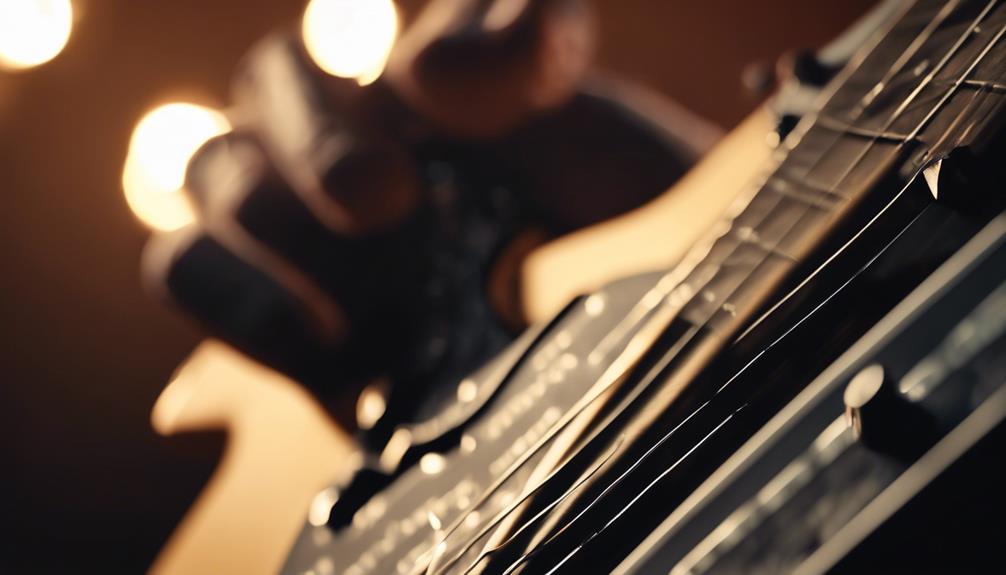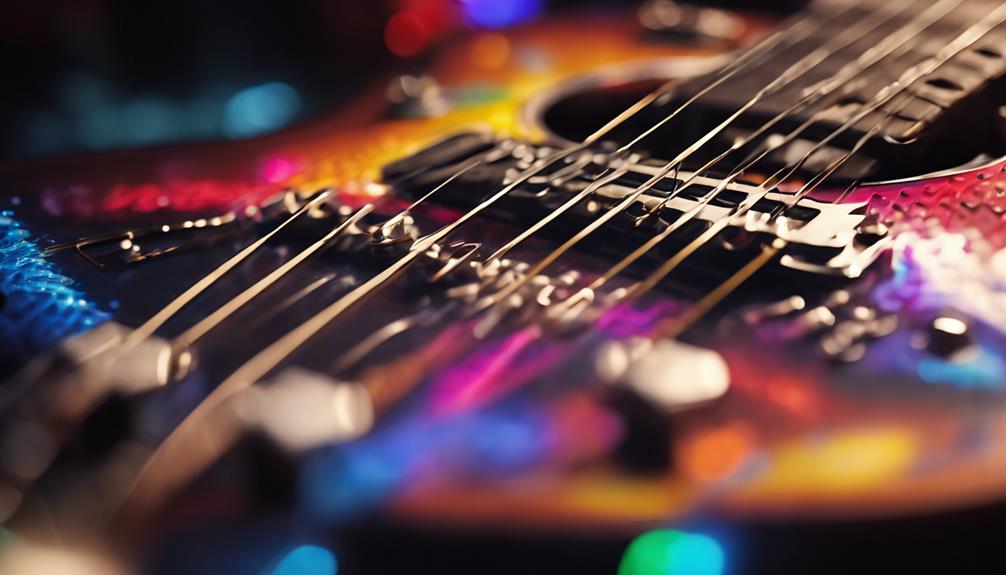If you’re looking to add some punch to your guitar playing, mastering power chords is essential.
Start by placing your index finger on the root note of your desired string and fret, and then position your ring finger two frets higher on the next string. Make sure your fingers are arched to avoid muting other strings.
Practicing this shape up and down the fretboard allows you to play different power chords with ease. But what’s the secret to making these chords sound like you’re playing guitar seamlessly?
Let’s explore the key techniques that will elevate your power chord game.
TL-DR
- Use the index finger on the root note and the ring finger two frets higher on the next string.
- Practice power chords on both the E and A strings for versatility.
- Ensure consistent finger placement to maintain the power chord shape.
- Focus on smooth transitions between power chords for fluid playing.
- Incorporate common progressions like I-V-IV to enhance your skills.
Understanding Power Chords

Power chords are simple, powerful, and a great starting point for any guitarist. When you play a power chord, you focus on just two notes: the root and the fifth. This gives the chord its strong, punchy sound that’s perfect for many music styles, especially rock and punk.
To play a basic power chord, let’s use a G5 as an example. Place your index finger on the third fret of the low E string, which is your root note (G). Next, place your ring finger on the fifth fret of the A string, which is the fifth of the chord. If you want to add some extra power, you can include the root note one octave higher by placing your pinky on the fifth fret of the D string.
Power chords are versatile because they don’t include major or minor third intervals, making them neutral and adaptable to various musical contexts. They’re often notated by the root note name followed by the number 5, such as G5 or C5.
Whether you’re strumming away on an acoustic or shredding on an electric guitar, mastering power chords is essential to building your foundation in guitar music.
Power Chord Shapes
Ever wondered how you can play different power chords up and down the neck with ease? The secret lies in understanding the power chord shape.
When playing power chords, you’ll often use one shape that you can move around the fretboard. This shape typically involves placing your index finger on the root note and your ring finger two frets up on the next string.
For example, to play a G power chord, place your index finger on the third fret of the low E string (the root note, G) and your ring finger on the fifth fret of the A string (the fifth, D). This shape spans two strings and produces a powerful, clean sound.
The beauty of this chord shape is its versatility. You can slide it up and down the neck to play different power chords. Simply move your hand to a new root note and maintain the same finger positioning.
Whether you’re playing an A power chord, a B power chord, or any other, the shape remains consistent.
Experiment with different notes and positions to create varied chord progressions. Remember, practice muting unused strings to avoid unwanted noise and focus on the power of those two strings.
Playing Power Chords

To master playing power chords, start by positioning your fingers correctly on the fretboard. Place your index finger on the root note of the chord, usually on the E or A string. Then, use your ring finger to press down on the string two frets higher, which represents the fifth. If you’re playing the three-string version, you’ll also use your pinky finger to press the string directly below the fifth.
Power chords rely on the root and the fifth, giving them a strong, clear sound that fits well in various styles of music. They don’t have major or minor quality, making them versatile.
The shape of power chords is movable; once you learn how to play one, you can slide the same shape up and down the fretboard to shift between different chords like G, C, and D.
Often, power chords are easier to play than barre chords and can help you get used to finger placement and pressure. Practice on both the E and G strings to diversify your playing.
Mastering this technique enhances finger strength and dexterity, essential for advanced guitar playing.
Practicing Power Chords
Now that you’ve learned the basics of playing power chords, it’s time to integrate them into your practice routine for improved proficiency. Start by practicing the classic E5 power chord: place your index finger on the third fret of the low E string and your ring finger on the fifth fret of the A string. This consistent finger placement technique will help you play power chords accurately.
To enhance your practice, try using software like Guitar Pro or mobile apps that can guide you through various exercises. Focus on smooth shifts between power chords to improve your speed and accuracy. For instance, move from E5 to A5 by moving your fingers up one string each while maintaining the same fret positions.
Experiment with different strumming techniques to add dynamics to your playing. Try incorporating power chords into well-known songs like ‘Smells Like Teen Spirit.’ This will make your practice sessions more enjoyable and practical.
In addition, practice common progressions such as I-V-IV using power chords. This will help you understand how these chords fit into various musical contexts and improve your overall guitar skills. With consistent practice, you’ll master the art of playing power chords and become a more versatile guitarist.
Chord Progressions

When practicing chord progressions, start by moving between power chords like G, C, and D to create fluid musical sequences.
Begin with a G power chord, then replicate the shape on adjacent strings to find a C chord by shifting up. Next, move the same shape up two frets from C to locate the D chord. This will set the foundation for your chord progressions.
To build smooth progressions, practice moving between these chords without pausing. Focus on keeping your fingers in the same shape and simply shifting your hand along the neck. This will help develop rhythmic patterns essential for musical fluency. Start slowly and gradually increase your speed as you become more comfortable.
Incorporating different rhythmic patterns while alternating between G, C, and D will enhance your creativity. Experiment with strumming techniques and timing variations to find what suits your style.
Consistent practice of these progressions will make your chord progressions more dynamic and expressive.
Next up, learn how to speed up guitar chord changes in this guide.
